Updated 13 December 2022
We moved from the North a number of years ago from a soft water area to Chatteris, Cambridgeshire which has water classified as Hard, the effect of this is that soap doesn’t lather easily and appliance heating elements get coated in limescale reducing efficiency and life.
As a home improvement project, I decided to research water softeners.
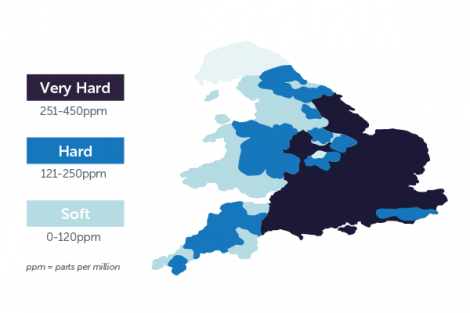
How is Hard Water Quantified
Parts Per Million (ppm)
This scale is used to measure very small amounts of something in a larger quantity of liquid. It is used to measure dilute concentrations of chemical substances. One litre of water weight 1 million milligrams (mg). So 1 part per million (ppm) would mean the chemical is one millionth of the solution, or 1mg per litre.
For water hardness levels, we measure parts per million of minerals including calcium carbonate (CACO3) in the water. Calcium carbonate is the compound in hard water that causes limescale build-up. Soft water typically has less than 50 ppm of calcium carbonate. Hard water has over 200ppm, Anglia Water drinking water quality information for the Chatteris area shows that the level is 230ppm compared to where we used to live which was 17.5ppm.
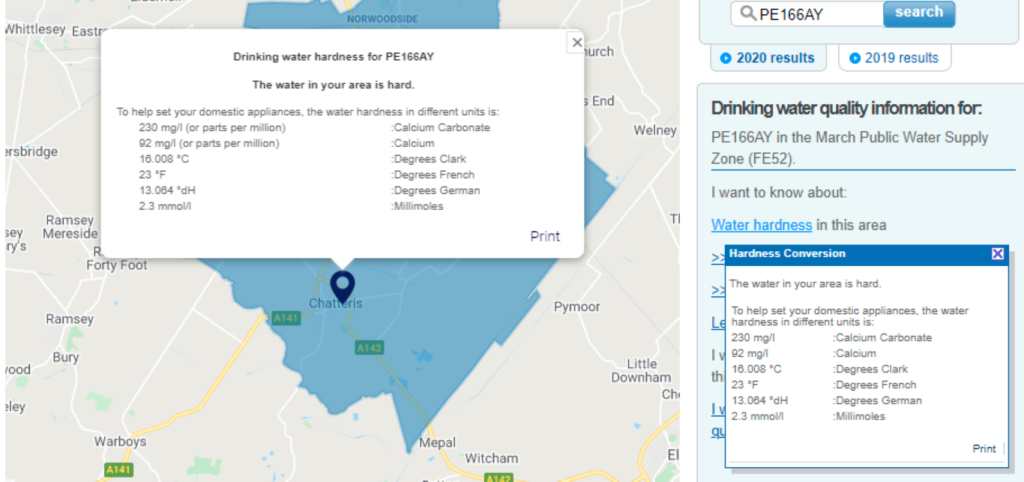
I bought a water hardness test kit from Toolstation and this indicated that my incoming cold water was between 240ppm ~ 280ppm so I know the extent of the hardness which be of use later.
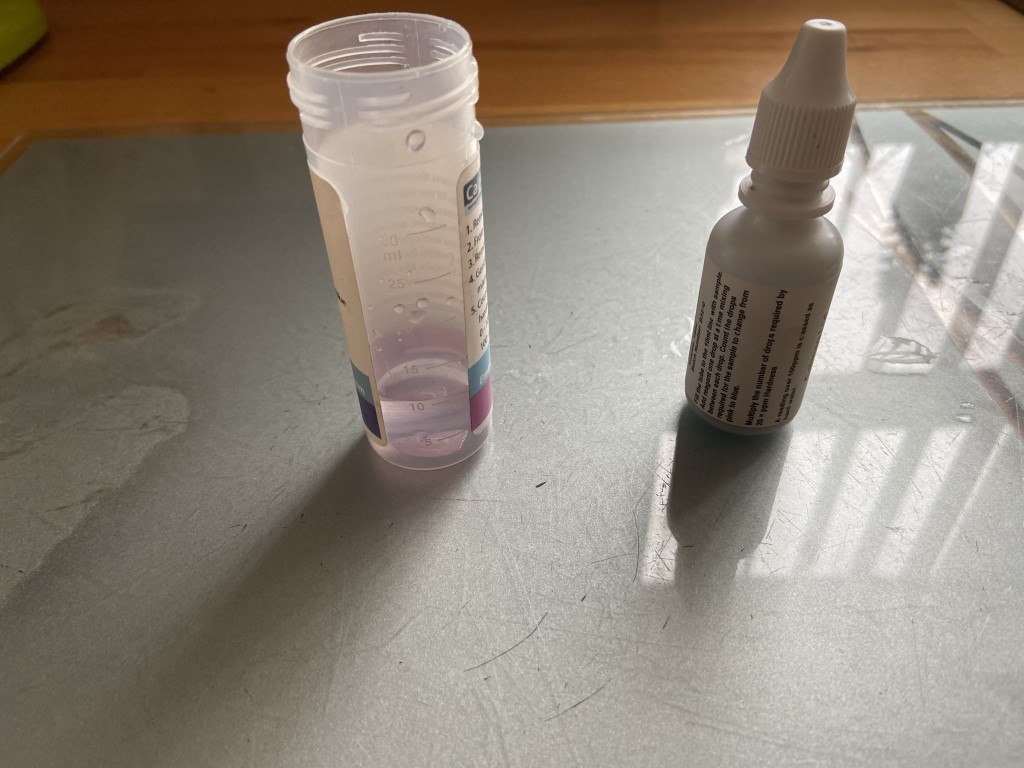
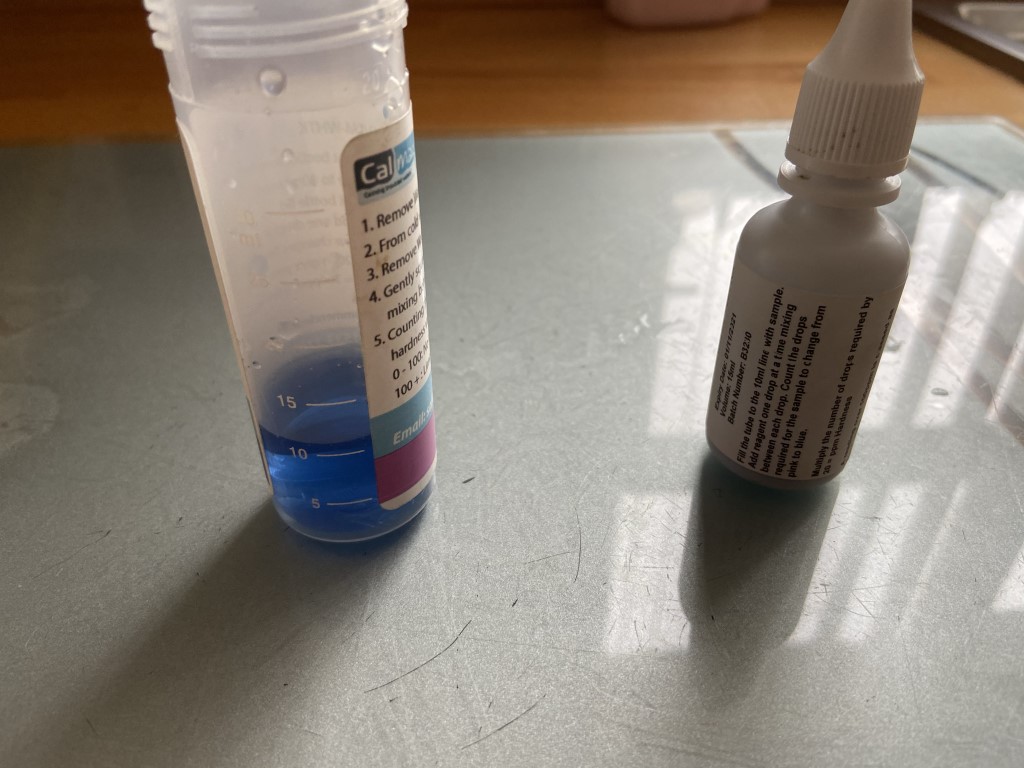
Water Softeners
These work by ion exchange, incoming hard water passes through a bed of activated resin beads, these beads remove the calcium carbonate and magnesium molecules as the water passes through the resin chamber, the exiting water is now free of the limescale causing molecules and is now soft.
To maintain the resins ability to ion exchange the resin is backflushed with a brine solution, the backflush waste water goes directly to drain.
There are a number of considerations to take into account in selecting a water softener, these are:
- Cost to purchase
- Cost to run
- Salt – Block or Granular
- Number of bathrooms
- Number of people living in the property
- Incoming water pressure
- Single or Two resin chambers
- Type of hot water system (Gravity, Indirect or combi boiler)
- Electrical supply required or not
- Physical size of the softener and where will it go
- Warranty
- Dealers
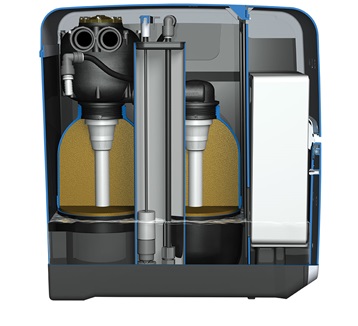
What did we choose and why
I’m definitely no expert on water softeners, first port of call was the internet and YouTube to see what were the popular UK models and to read reviews that users made on dealer sites.
Going through the above list, the purchase and running cost will be known after most of the other points are answered.
3 live in the property and we have 2 bathrooms (ensuite shower is classed as a bathroom), the hot water is supplied from an unvented indirect cylinder, meaning the hot water is under a constant pressure and pushed out of the cylinder to the hot tap by the incoming water pressure at the bottom of the cylinder, the incoming pressure is typically maintained at 3 bar so that the hot & cold taps and mixer showers for example are at the same pressure.
Where the hot water uses the incoming water pressure, a High Flow (HF) unit will be required as the flow rate is higher through the resin chambers to reduce any pressure drops, also the softener inlet and outlet pipes are larger.
If the water pressure to the house was low, introducing the water softener might cause a problem, I measured the pressure here at 2.8 bar (40psi) which is fine, a pressure gauge is available from Toolstation.
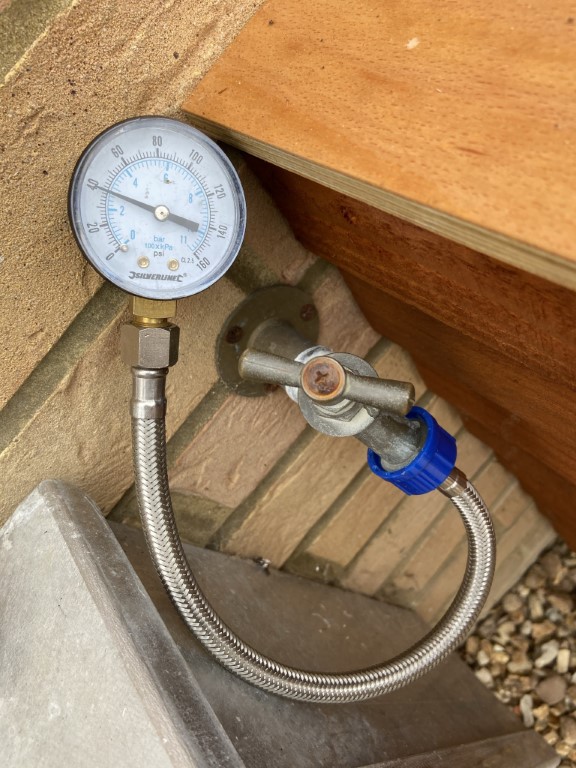
The activated resin chamber I mentioned earlier needs to be regenerated, (back flushing the beads with brine (salt solution)), with a single chamber, softened water will not be available during the regeneration process, we opted for a dual chamber unit so we always have a supply of softened water, however this does have a cost implication.
How does the softener know it needs to be regenerated?
Two methods, timed or metered. With a timed version, an electrically powered (low voltage via a transformer) timer will trigger the process, the main disadvantage apart from requiring a power source is that regeneration could occur if no softened water was used, but simply based on time.
A strong advantage of an electrically powered softener is the ability to have an alarm indication on low salt, with a mechanical only unit, you have to physically monitor this (but I’m working on it 🙂).
The softener we selected used actual metered soft water usage to mechanically trigger regeneration
The model which satisfied all our requirements including a 10 year warranty was the Kinetico Premier Compact HF which we bought from Aquastream Water Softeners Ltd who gave exceptional service, they responded to my emails quickly and are experts in their field, I would not hesitate in highly recommending them.
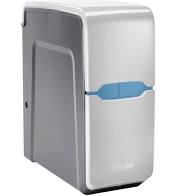

Installation
If you are a confident at DIY, the plumbing for the water softener is very easy, with only two pipes and a drain hose, the price of the softener included the 22mm Bypass kit which contains all the full bore valves, strainers and 0.75m flexible hoses to connect the houses fixed plumbing to the softener.
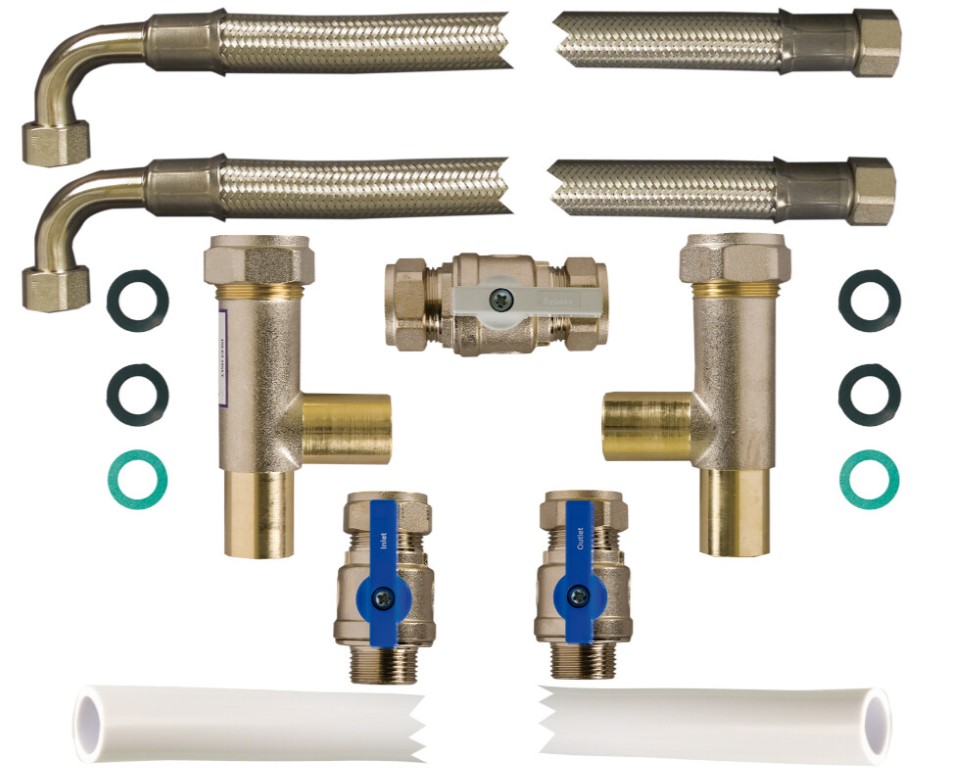
Due to the underneath of the kitchen sink base unit being full of other stuff, we decided to put the unit outside and to build a wooden insulated enclosure for it.
As we replaced the kitchen a few years ago, I knew where the incoming water pipes run, from the picture below you can see the rising main and stop cock, this tees off for the kitchen sink, with the 22mm copper pipe transitioning to John Guest 22mm push fit disappearing behind the dot & dab plaster boarded wall on its way to upstairs.
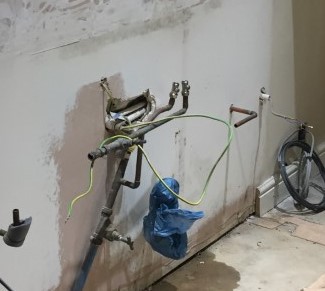
The kitchen base cabinets were a bit too ‘busy’ for the softener to fit but left enough room for me to access the buried pipes once a hole is made in the cabinet back .
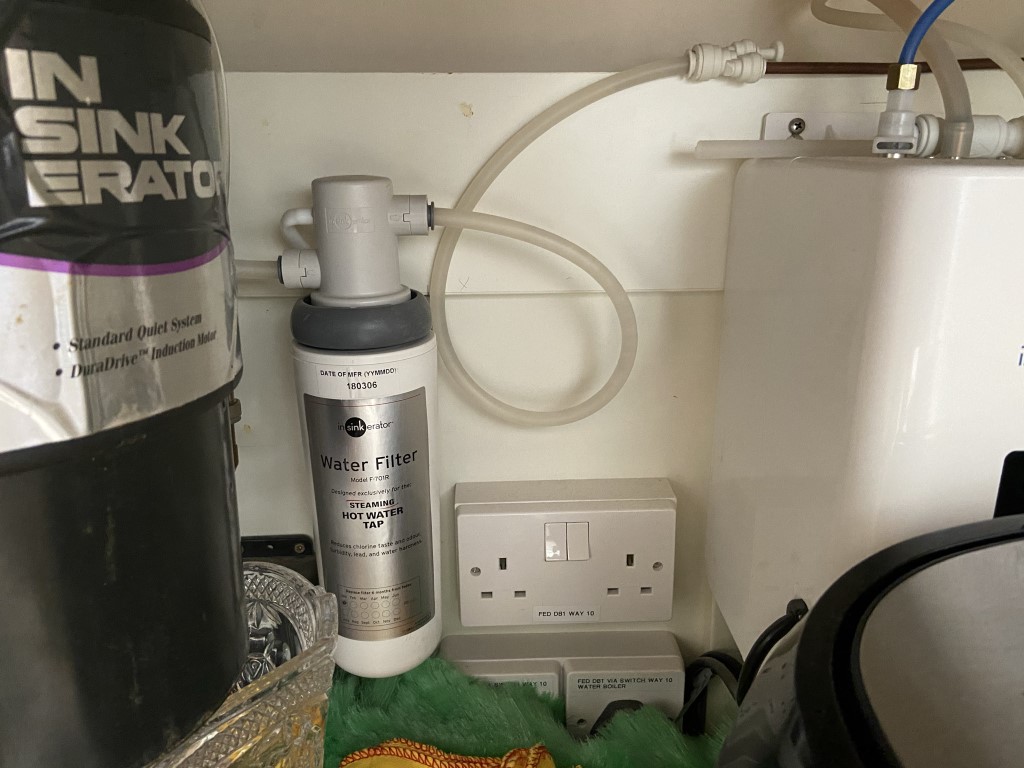
Once the cabinets back was cut out and plasterboard removed to expose the 22mm plastic cold water pipe, two 32mm holes were drilled to outside, the holes then sleeved with 28mm copper pipes ready for the 22mm copper passing through these to outside.
The water supply to the Insinkerator hot water boiler is from the valve on the left of the picture, the boiler water feed will be moved from hard to soft.
It is important to keep the kitchen sink cold tap feed before the water softener for cooking and untreated drinking water, it is also advisable to supply any outside taps before the softener to save on salt usage and prevent damage plants over time.
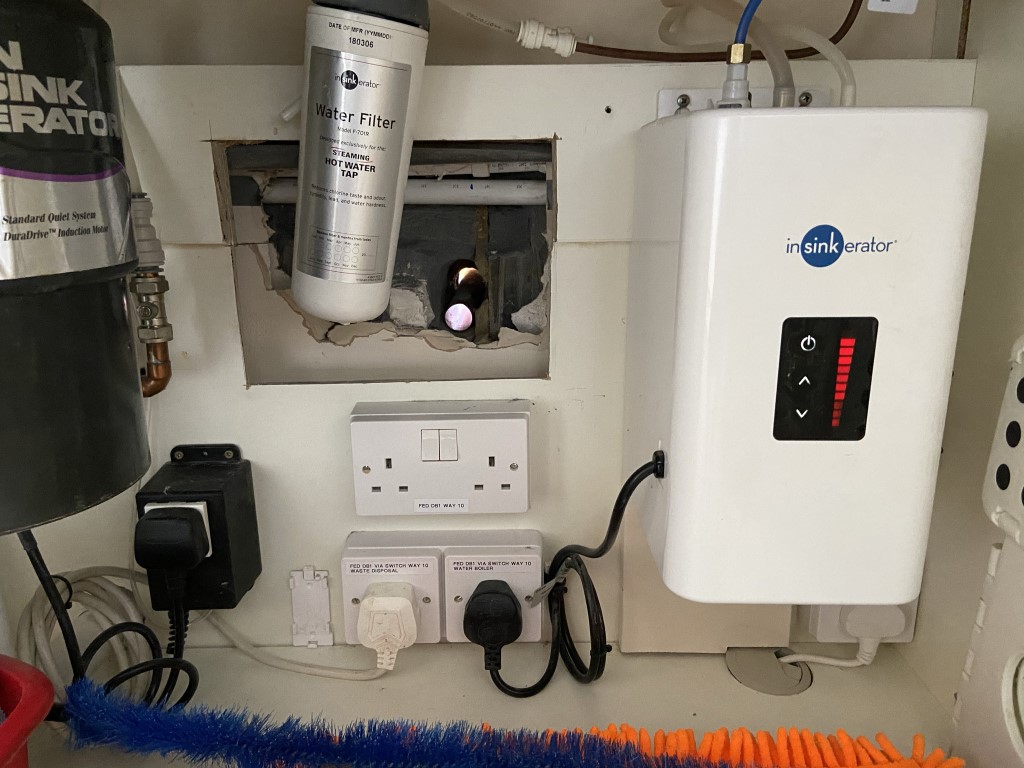
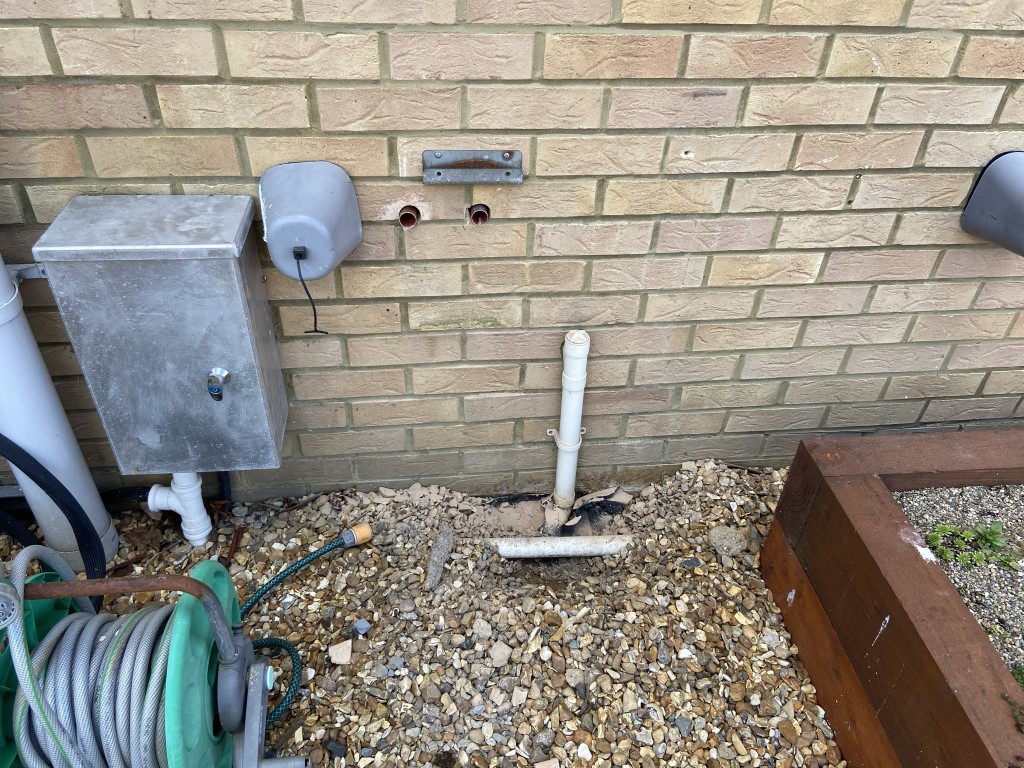
I used ‘O’ rings around the 22mm pipes to keep them centralized within the through wall sleeves.
To make the plastic pipe to fitting connection, it is important to cut plastic pipe to leave a clean cut and to use superseal pipe inserts, marking the depth of the fitting on the pipe before pushing it onto the pipe ensures that it is fully seated.
The pipe cutter I used came from Lidl and cost £5.99

On the John Guest pipe their are fitting engagement marks already made to assist with ensuring the fitting is fully pushed over the pipe, but my fittings didn’t marry up with these, so I measured and marked the pipe to confirm the elbow and Tee were fully engaged before pushing them home and tightening the collet ring after which I pushed on the locking rings (Blue clips).
The 15mm copper pipe leaving the Tee in the picture below, is the new softened water supply to the hot water boiler, all the copper elbows (15mm for the water boiler and 22mm for the softener) are long street elbows, this reduces joints and saves space which was ideal in my situation.
To keep everything in place and to insulate the pipes I used expanding foam, two other pipes are in the picture, one is for the outside taps which I lagged internally when the kitchen was being fitted, the other is another plastic pipe, this time 15mm for the kitchen sinks hot water tap.
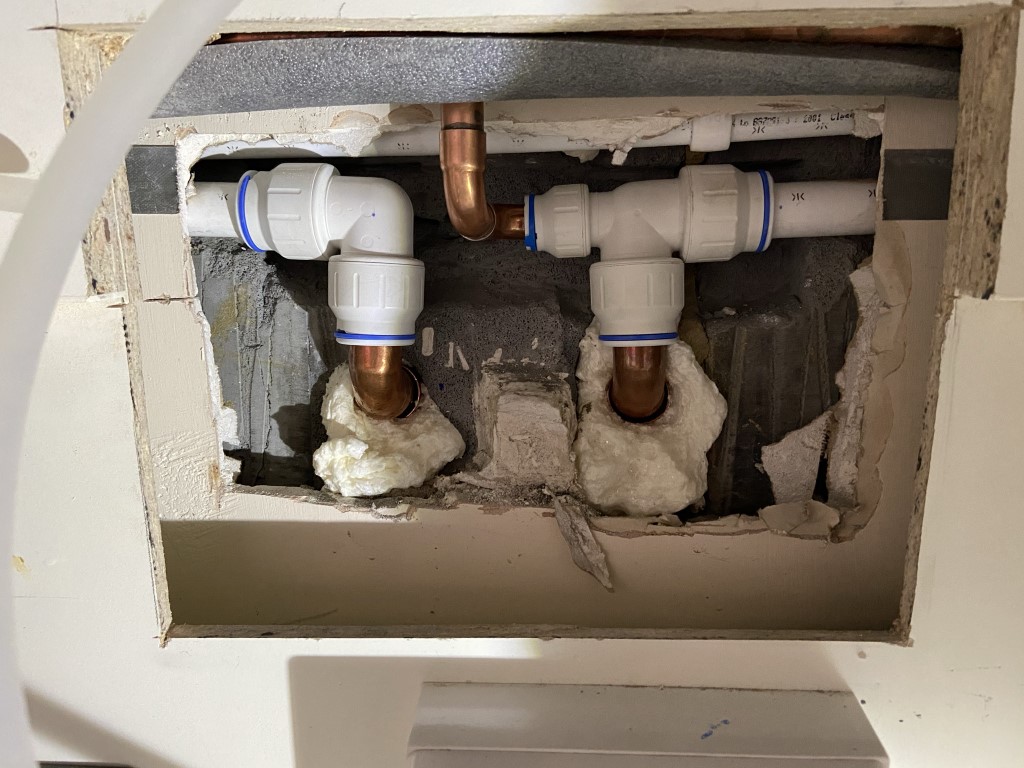
With the cover on, nobody would know the carnage 🙂
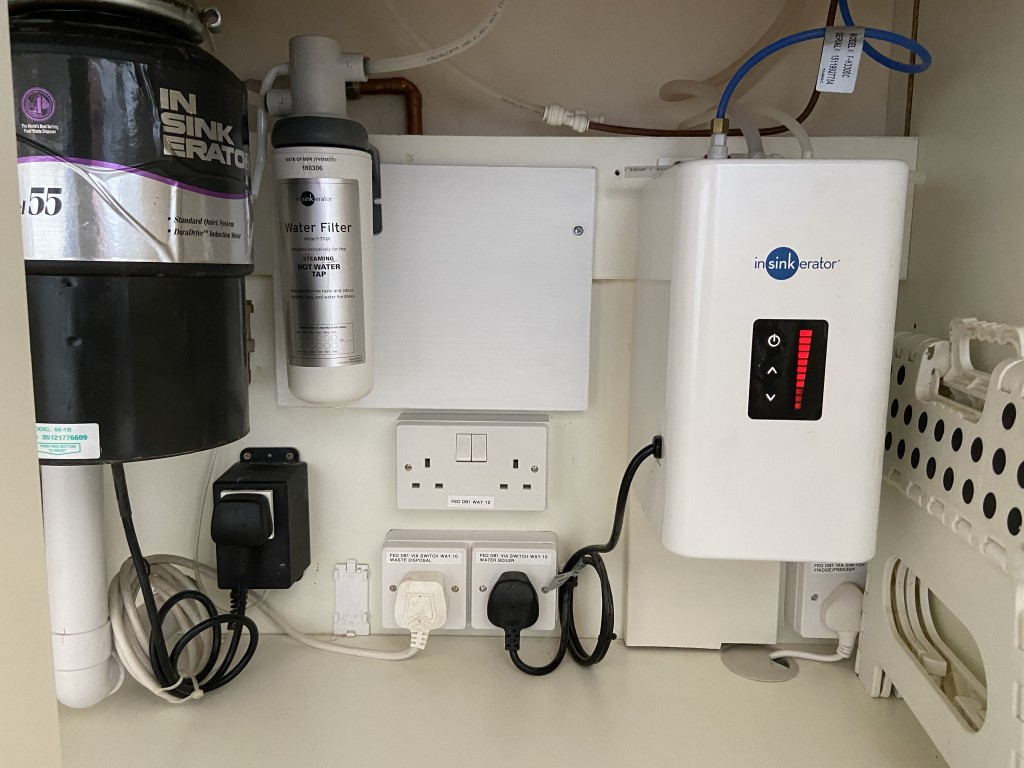
On the outside the bypass valves and copper runoff to drain installed.
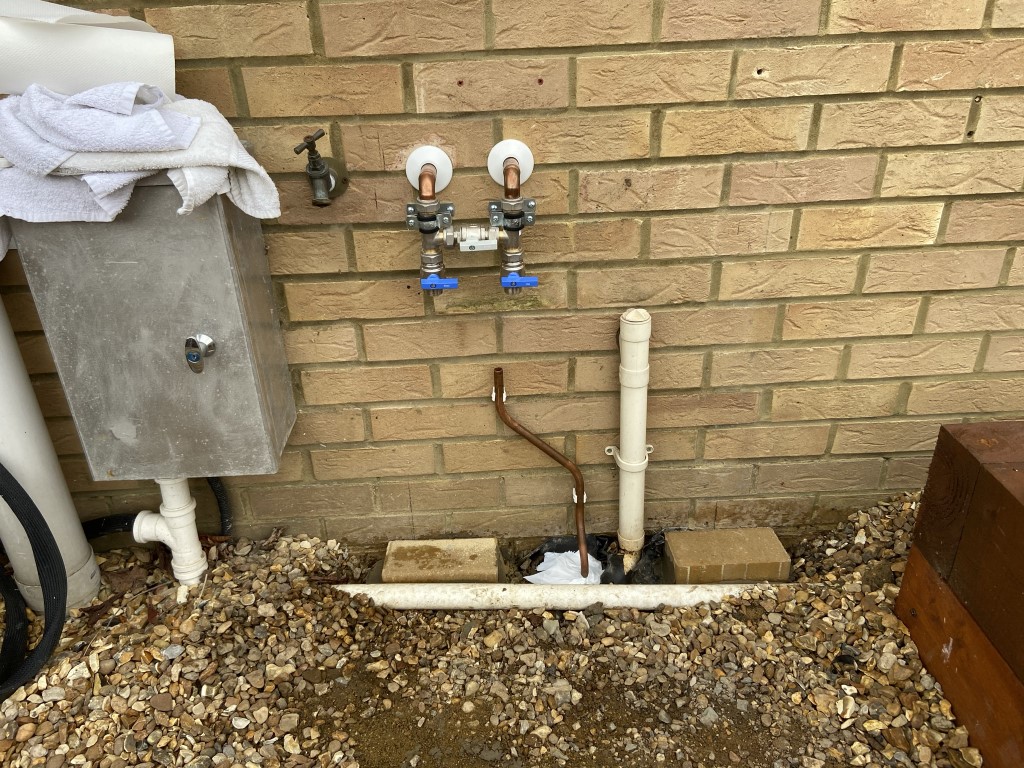
The copper pipe is the regeneration drain for when the resin chambers are back flushed and must be air gapped from the waste system to avoid any cross contamination with the drinking water. The cold water inlet to the softener must have a a non return valve to prevent back flow.
Finished installation, the Kinetico softener is off the ground sitting on a 50mm polystyrene backed base, 22mm stainless steel braided hoses each have a strainer fitted and to ensure that the softener doesn’t freeze, I have taken the precaution of installing a 40 Watt thermostatically controlled tube heater from Toolstation.
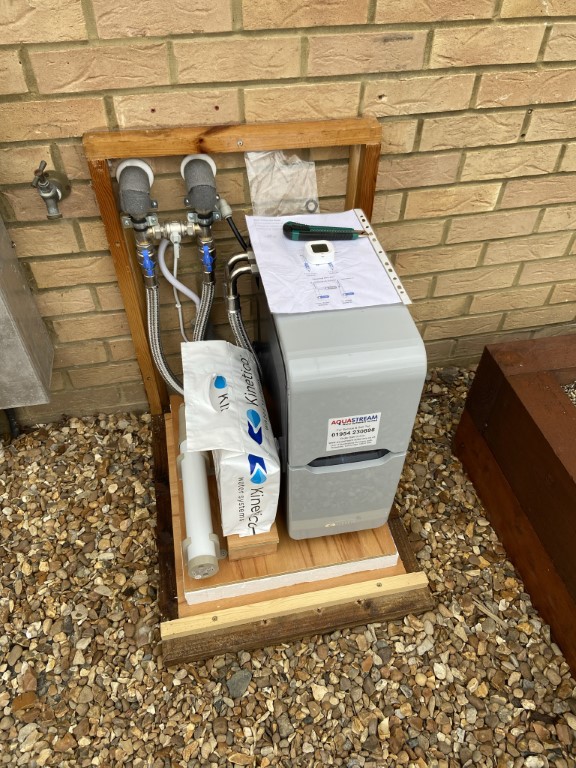
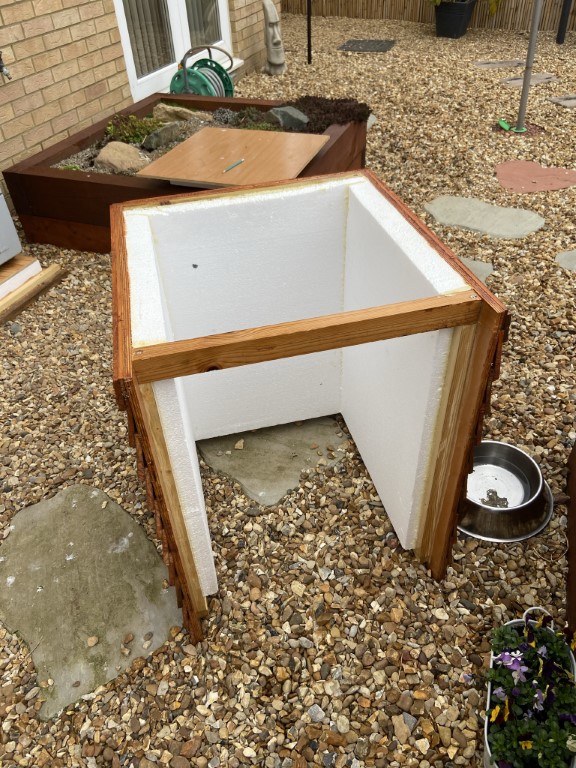
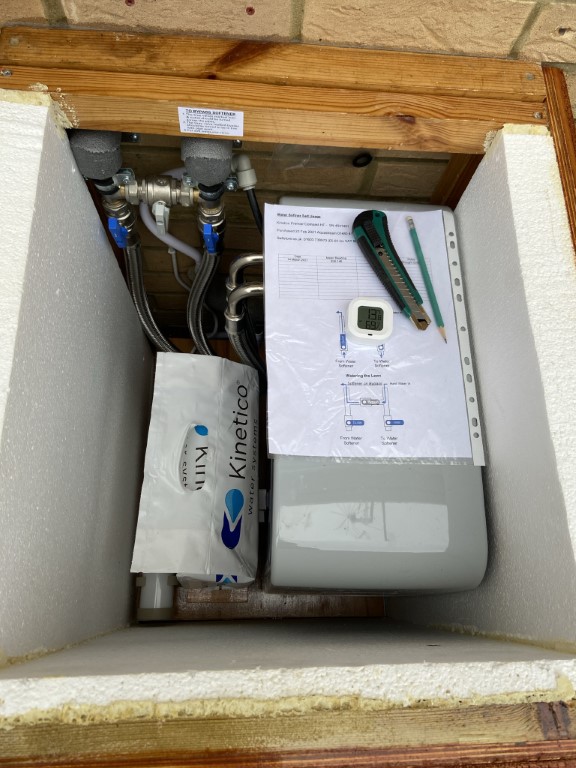
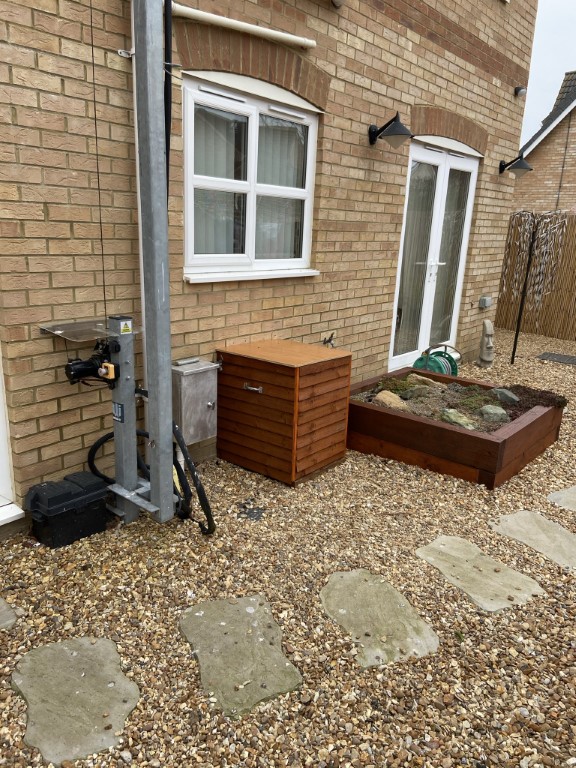
Pipe Schematic
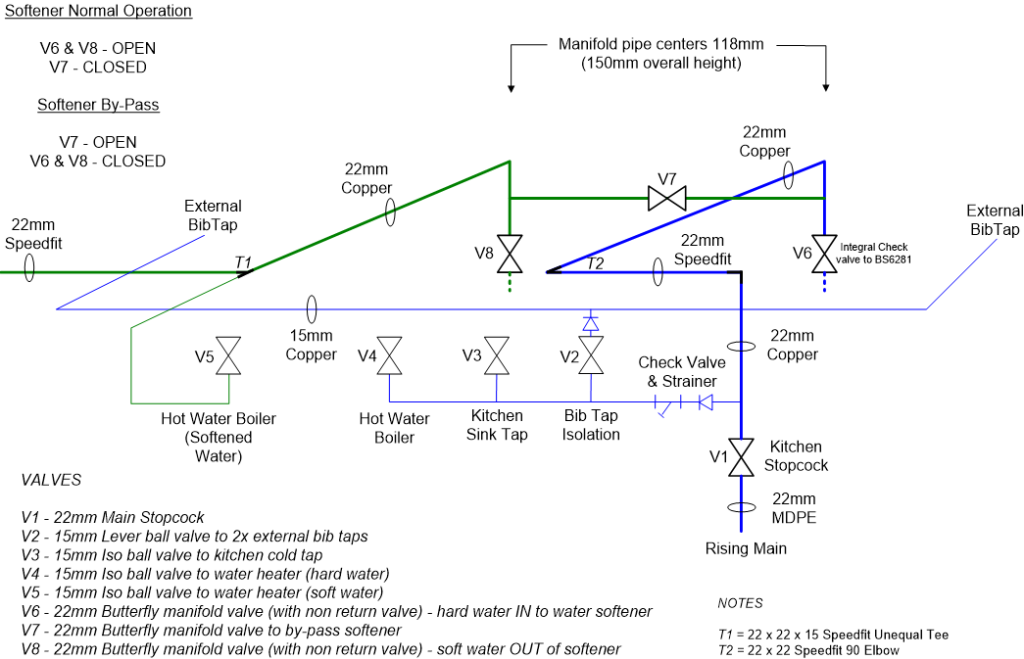
What are the Running Costs
The cost of the softener including bypass valve arrangement and 2 x 8Kg blocks of salt including factory setup was £1,295.00 inc VAT which was as cheap as I could find.
The only consumable other than regeneration water is Kinetico Block salt, the cost varies tremendously and I have found Saltstore to be the most competitive with an excellent online ordering system and friendly staff.

I have mentioned water hardness and the metered chamber regenerations, the Kinetico uses different metering disc types in their machines depending on water hardness, this directly impacts on the number of regenerations.
For my areas water hardness a Type 6 disc, which regulates regeneration frequency based on flow through the softener, is installed, therefore after 327 litres of softened water has passed through the resin bed, the cylinder will regenerate using 20.5 litres of water and 0.34Kg of salt.
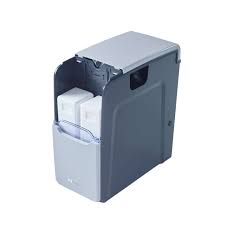
After referring to the specification table, I did query with Aquastream Water Softeners the reason for supplying a Type 6 disk with my softener as this is for up to 362ppm and in my area the maximum I have measured was 280ppm which would be within the scope of a Type 5 disc (305ppm).
The answer was based on their experience and knowledge in that the table values are factory test bench conditions and not real world, the water in Chatteris is typically around 300ppm and very low flow through the softener would not be metered, therefore their is a risk that we could have hard water before the softener regenerated which made perfect sense. Good to know.
The following spreadsheet shows the actual 2021/2022 annual costs based on current usage:
Actual Running Costs
The cost of 8Kg of salt increased to £6 in 2022, the softener uses ~ 11.35mm of salt per day based on my usage circumstances, therefore, the cost of salt per year is £78.00.
For two years before the softener was installed, my annual usage was steady at199m3, after a year in use of the softener, my metered water usage has risen to 127m3, therefore, the water used in the ‘Regeneration Cycle’ was 8m3 costing £13.47.
The total running cost is £91.47 per year or 25p per day.
In Use
The softened water is fine to drink with no trace of a salty taste, soap lathers well with either hot or cold water, skin no longer feels dry and Barneys cocker spaniels coat is nice and silky now.
I need to remember to put the softener in bypass when I top up the central heating pressure, so I have a reminder drawing in the softener cabinet.
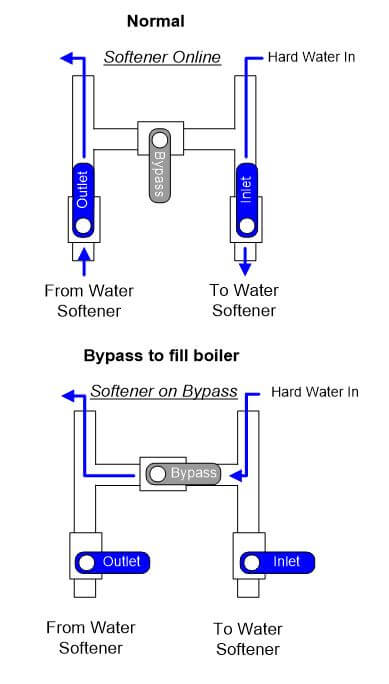
Update
The softener has performed faultlessly, salt block usage is consistent, however, the price of salt has increased marginally, probably to reflect the increased cost of fuel.
Two observations since the installation have been:
- I record and upload water meter readings every time I replenish the salt blocks and this led to the discovery that my water meter was failing due to the low recorded water usage, Anglian Water replaced the meter and the blog on that is HERE.
- I have not monitored the effectiveness of the 40watt tubular heater in cold weather until now, and I’m happy that the wattage is more than sufficient to keep the water in the pipes from freezing.
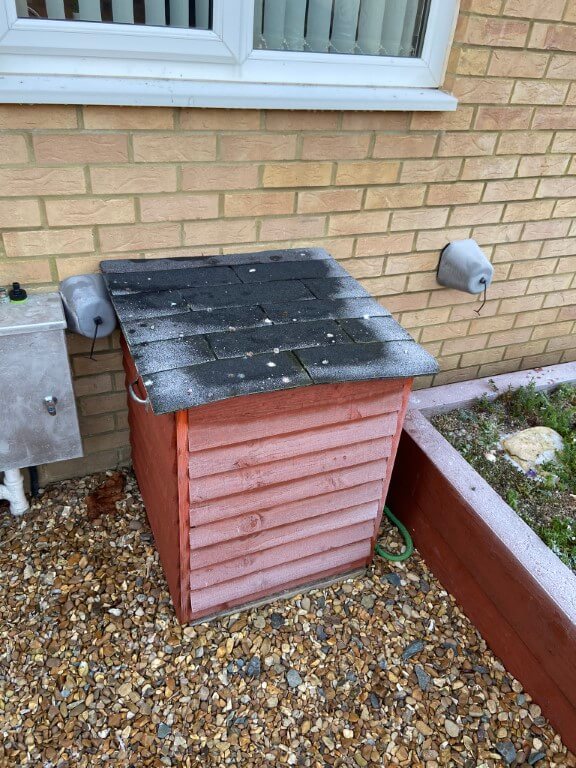
External water softener enclosure at -5.6oC, the internal 40W heater is ON and the picture shows where heat loss is occurring on the lid, internally the temperature is at +7.1oC, so all is good.
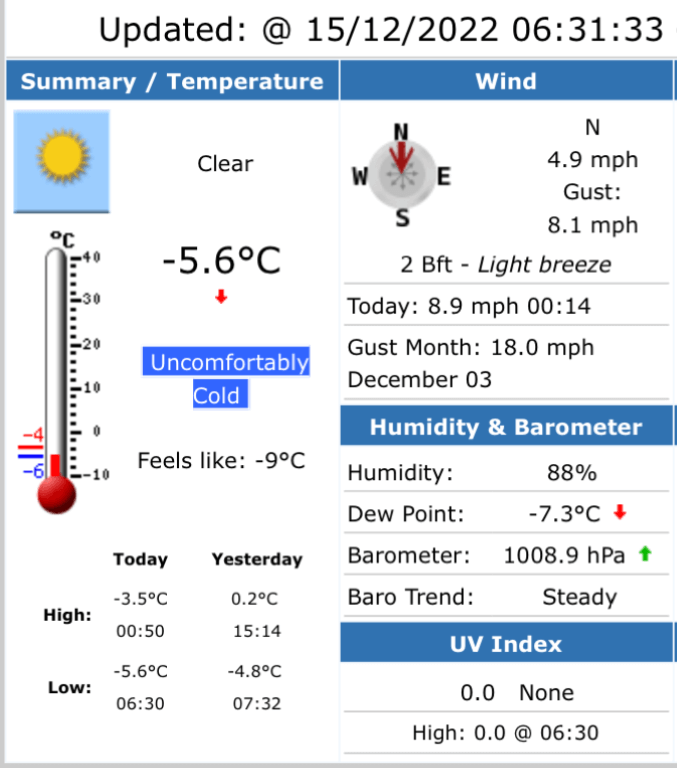
External temperature -5.6oC and has not got above freezing for a few days.
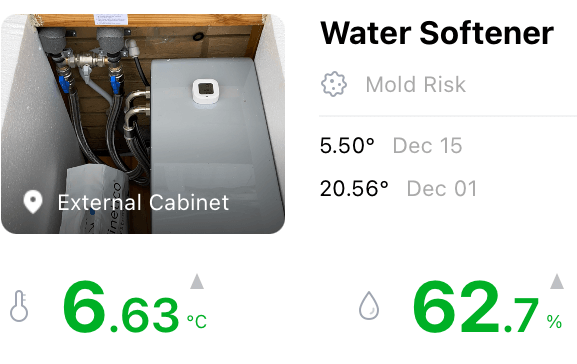
The ‘Sensor Blue’ within the softener cabinet shows a temperature of 7.10C indicating that the heater is working perfectly.

